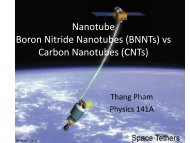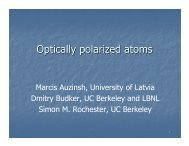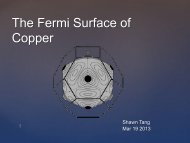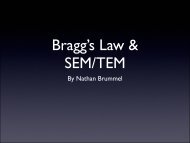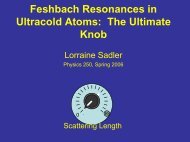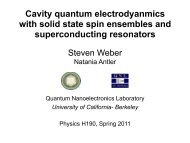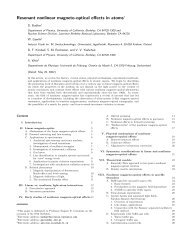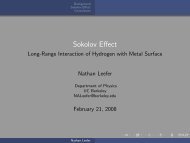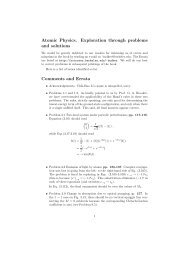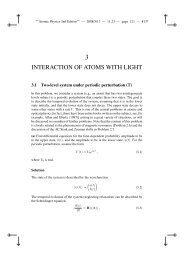Atomic Tests of Discrete Symmetries at Berkeley - The Budker Group
Atomic Tests of Discrete Symmetries at Berkeley - The Budker Group
Atomic Tests of Discrete Symmetries at Berkeley - The Budker Group
Create successful ePaper yourself
Turn your PDF publications into a flip-book with our unique Google optimized e-Paper software.
FIGURE 4.<br />
Experimental Appar<strong>at</strong>us for Yb PNC measurement.<br />
suggest th<strong>at</strong> this geometry is less sensitive to system<strong>at</strong>ic effects associ<strong>at</strong>ed with the<br />
nonzero M1 transition amplitude between the 6s 2 1 S 0 and 5d6s 3 D 1 st<strong>at</strong>es.<br />
During the past several years, we have pursued a detailed study <strong>of</strong> the spectroscopic<br />
parameters relevant to performing a PNC experiment in <strong>at</strong>omic Yb. <strong>The</strong>se preliminary<br />
investig<strong>at</strong>ions included measurements <strong>of</strong> the lifetimes <strong>of</strong> many relevant st<strong>at</strong>es, dc-<br />
Stark shifts, hyperfine and isotope shifts, and the Stark-induced amplitudes for both the<br />
6s 2 1 S 0 → 5d6s 3 D 1 transition and the 6s 2 1 S 0 → 5d6s 3 D 2 transition, another candid<strong>at</strong>e<br />
for a PNC experiment [23, 21]. Most recently we have completed a measurement <strong>of</strong> the<br />
highly forbidden M1 transition amplitude between the 6s 2 1 S 0 st<strong>at</strong>e and the 5d6s 3 D 1<br />
st<strong>at</strong>e using the Stark-interference technique [24]. All <strong>of</strong> these measurements have confirmed<br />
our understanding <strong>of</strong> the system and lead us to believe a high-precision test <strong>of</strong><br />
PNC in Yb using the Stark-interference technique in an <strong>at</strong>omic beam is feasible.<br />
One remaining question for the Stark-interference <strong>at</strong>omic beam experiment concerns<br />
the use <strong>of</strong> the power-build-up cavity in order to increase the number <strong>of</strong> <strong>at</strong>oms making<br />
the transition. <strong>The</strong> ac-Stark shifts resulting from the high-intensity standing wave inside<br />
the power-build-up cavity serve to broaden the <strong>at</strong>omic resonance. At high powers, some<br />
<strong>of</strong> the <strong>at</strong>oms are shifted out <strong>of</strong> resonance, decreasing the overall signal. Because the<br />
ac-Stark shift depends on the intensity <strong>of</strong> the light and the signal depends only on





